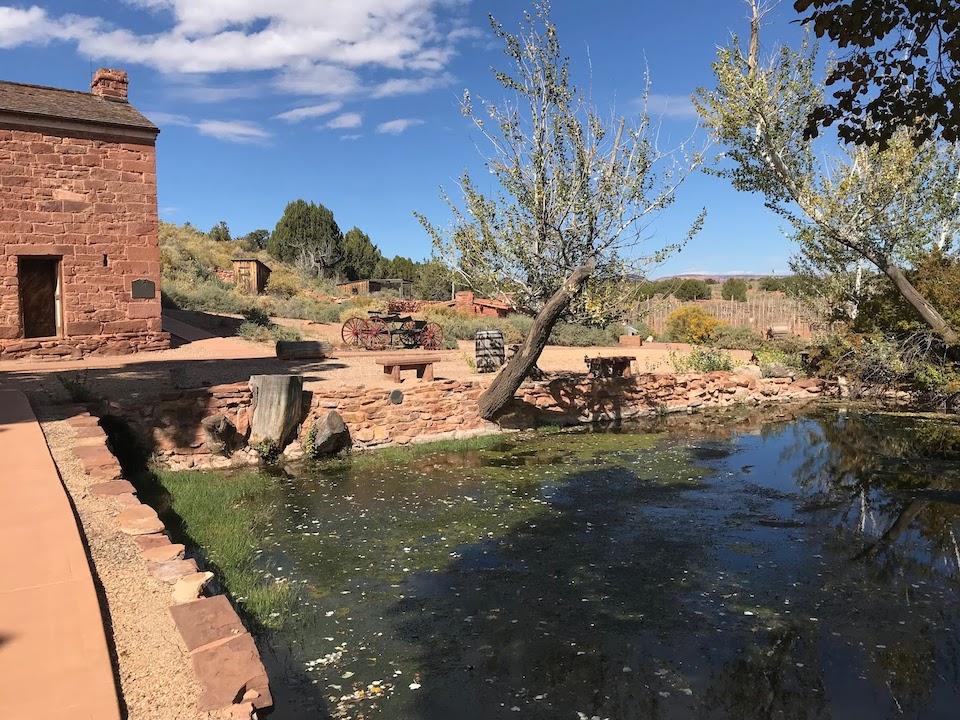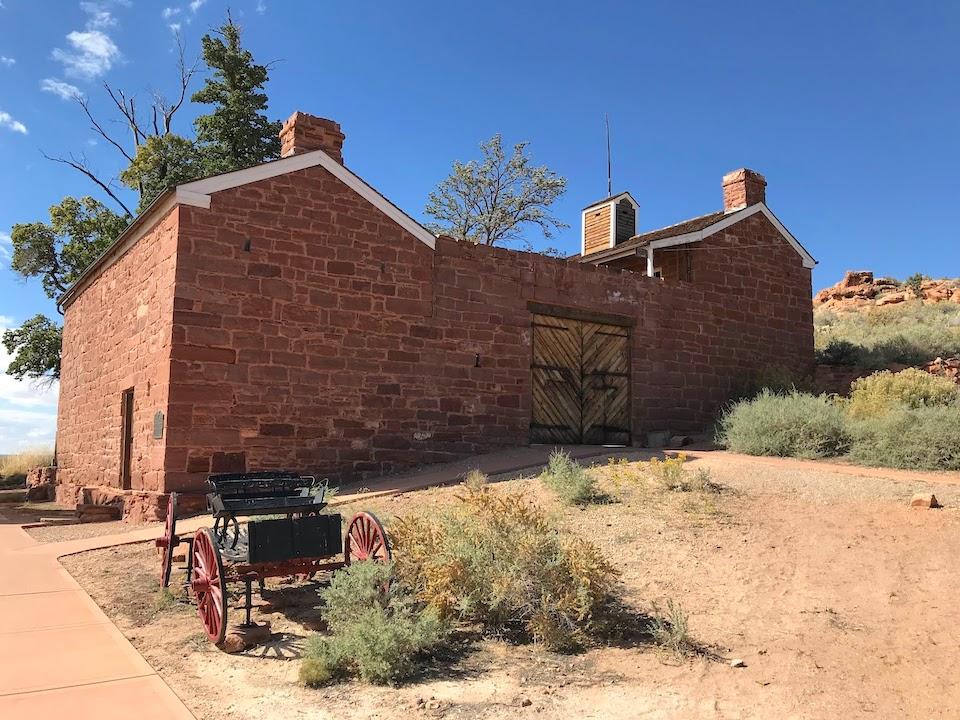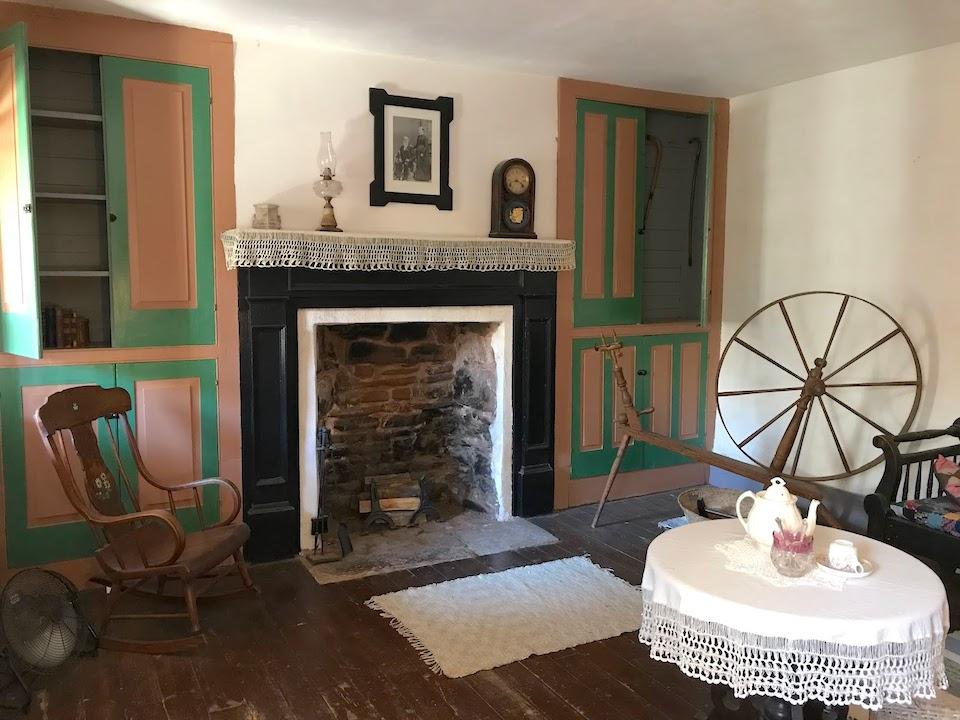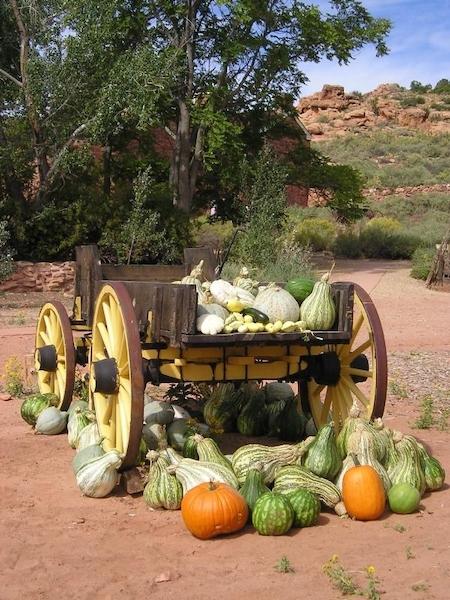
Spring waters at Pipe Spring National Monument/Jim Stratton
Water defines the arid West. Sporadic and intermittent water - think flash floods, freeze/thaw and steady erosion - sculpts the landscape, but it takes permanent water to create conditions for human settlement. At Pipe Spring National Monument in northern Arizona, the Park Service has done an exemplary job of telling the human water story from three perspectives: Paiutes, the original inhabitants; Mormons, a big wave of Anglo settlers that stayed; and the U.S. government.
Pipe Spring gets it start as rainfall. About 10-12 inches fall here every year, but only an inch works its way through the red sandstone and into the aquifer. When that water hits the impermeable mudstone layer below the sandstone, it finds its way back to the surface by creating springs along the base of the red sandstone mesas. There are actually five springs at Pipe Spring, and they have supported human habitation since the ancestral Puebloans lived in the region some one thousand years ago. Because of this generous and reliable source of water, there was historically, and still is, a well-worn trail to Pipe Spring. Remnants of the historic wagon road leading to the site are visible from the mesa above the spring. Today the trail is Arizona Highway 389.
When Catholic missionaries seeking a route from Santa Fe to California first showed up in 1776, Paiute Indians lived in the area and used water from Pipe Spring to grow beans, squash and corn. Anglo ranchers began utilizing the water in the late 1850s and in 1863, James Whitmore, a Mormon rancher, homesteaded the land around and including the spring for his 11,000 sheep and 500 cattle. Meanwhile, Kit Carson was busy displacing the Navajo Nation from their ancestral lands. Displaced parties of Navajo were raiding in the Pipe Spring region, and they killed Whitmore and a ranchhand in 1866 as Whitmore sought to recover stolen cattle. However, local ranchers thought it was the Paiutes who killed Whitmore and the ranchhand, causing a conflict that really shouldn’t have happened. The Paiutes were not an aggressive people and they had co-existed with the Mormons and shared Pipe Spring since the first contact with Mormon ranchers.

Winsor Castle at Pipe Spring National Monument/Jim Stratton
Our Park Service interpretive ranger, Miranda, noted that individually Paiutes and Mormons got along quite well. The Church of Jesus Christ of Latter-day Saints didn’t subscribe to the “only good Indian is a dead Indian” mentality that was prevalent at this time in our history, though there were some armed conflicts between Mormons and local tribes. Seeing Native Americans as the lost tribe of Israel, the church sought to work with and live with these indigenous peoples. And there was a tremendous push to convert the Paiute to Mormonism, which didn’t work out very well. Culturally, there was continual conflict and misunderstanding over concepts of values, religion, and land ownership. For example, Paiutes could not understand why Mormon settlers could shoot deer whenever they wanted, but the Paiute could not shoot cows.
The perceived threat from the Paiute, caused by the misunderstanding over who killed Whitmore, and continuing raids by the Navajo ultimately led to the construction of a small stone fortress over the main spring area after Brigham Young purchased Pipe Spring from Whitmore’s widow in 1870. Effectively cut off from water they had used for centuries, the Paiute were forced away from the spring and lands they desperately needed for survival. Many Paiute died of disease or moved away as there was no federal government assistance, no treaty and, therefore, no local reservation until 1907.
This small stone fortress, called Winsor Castle after the first ranch manager, Anson Winsor, was constructed between 1870 and 1872 by 40 men from the Mormon Church. Red sandstone was quarried locally, but the roof timbers had to be cut and hauled from as far away as 50 miles. The church used Whitmore’s ranch and Pipe Spring as a “tithing” ranch. The Mormon Church required a 10 percent tithe from its members, many of whom could not pay in cash. So they paid annually in cattle and sheep, which were raised on church-owned ranches. Milk cows from Pipe Spring generated 40 pounds of butter and 60 pounds of cheese every day. The ranchhands also cultivated and irrigated a 10-acre garden that included pear and apple trees. A couple times a month, wagons of produce, butter, and cheese, along with several dozen steers, were sent to feed the workers building the Mormon Temple in St. George, a three-day wagon ride away.

Sitting room inside Winsor Castle at Pipe Spring National Monument/Jim Stratton
Ranger Miranda gave an excellent tour of Winsor Castle, which the Park Service has meticulously restored to what it looked like in the 1870s. Tours start on the hour from 10 a.m. to 3 p.m. daily. The house is built like a fort with high stone walls and thick wooden gates, but it was never attacked. The tour starts on the first floor sitting room and dining room. Upstairs are the sleeping quarters, including a “bridal suite” for newly married Mormon couples traveling to and from the Temple in St. George, where their marriages were sealed by the church.
Something that really caught my attention was a telegraph wire on the balcony leading into the house. We learned from Ranger Miranda that even before the house was constructed, Brigham Young had decreed that the far-flung outposts of the Mormon empire would be linked by telegraph to Salt Lake City. Post-Civil War, there was plenty of telegraph wire to be had cheaply. Brigham Young took advantage of its availability to string 995 miles of wire, linking remote sites, like Pipe Spring, from Idaho to Arizona. The telegraph operators were all single women who had their own space on the Castle’s first floor, just above the basement room built over the spring. The spring kept this basement room cool where butter and cheese were stored.
There is an RV park owned by the Kanab Paiute adjacent to the monument, but we had been camping for a month so sought out a real bed for a couple nights in Kanab, Utah. About 30 minutes from Pipe Spring, Kanab is the place for lodging and restaurants and it boasts of a long history supporting mostly Western movies and TV shows filmed in the area. There is interesting movie trivia signage all over town. Pipe Spring can be seen in the TV series Death Valley Days and the 1977 version of Last of the Mohicans. And at the visitor center, I learned that Winsor Castle was the inspiration for the Withersteen Ranch in Zane Grey’s “Riders of the Purple Sage.” Kanab hosts an excellent book store/coffee shop/outdoor store (a wonderful combination) and several good restaurants, including our favorite, the Flying V Café. For a quick bite and a local beer after visiting Pipe Spring, we drove a short 18 miles to Colorado City, Arizona, and the Edge of The World Brewery. For a town historically steeped in Mormon fundamentalism, it was quite a treat to discover good pizza and cold beer!

Fed by the spring waters, the ranch's gardens are productive/NPS
The government first interacted with Pipe Spring when John Wesley Powell based out of the area while surveying the lands north of the Grand Canyon. It was his survey that placed these lands not in the predominantly Mormon Utah, but rather in Arizona. Powell was the first government representative to suggest federal support in the form of food and farm land for the Paiute. No one in Washington listened until 1907, when the General Land Office withdrew 138,000 acres for the Kanab Paiute. The next big government influence came in 1920 when Stephen Mather, the first director of the National Park Service, visited the site while on an automobile tour of the new big parks in the region. He foresaw Pipe Spring as a future stop between Zion and the Grand Canyon on a National Park-to-Park Highway as the automobile became more and more prevalent and more and more visitors came to the region.
The Mormon Church had divested itself of Pipe Spring in 1895 and the Park Service purchased its 40 acres from private owners in 1923 with funds donated by Union Pacific Railroad, the Mormon Church, some private individuals and Mather himself. The Park Service has a very nice visitor center, a reconstructed garden and orchard, livestock including cattle and chickens, and a short trail that leads above the site to a scenic view of the castle and surrounding lands. Ironically all this development has had a negative impact on the spring’s water flow. Wells dug by NPS, the local Kanab Band of Paiute Indians, and area ranchers have reduced the flow from 50 gallons/minute to 5 gallons/minute. NPS hydrologists speculate the spring could dry up within 10-20 years.
The 1923 presidential decree establishing Pipe Spring as a “memorial of western pioneer life” has been expanded as the Park Service developed the story here. It is a story not only of pioneers, but also the original inhabitants and what happened when their culture collided with the pioneer life. And it’s the story of the Park Service bringing these valuable perspectives to our attention. Should you ever find yourself on Highway 89 in Kanab, Utah, or on Highway 389 just outside of Colorado City, Arizona, follow Stephen Mather’s vision, pull your car over and spend some time at Pipe Spring.
Traveler footnote: Jim Stratton long served as the Alaska regional director for the National Parks Conservation Association. For more of his stories, check out his blog.



Comments
Great place for a visit. Be sure to stop here along the way to somewhere else for a short spell to enjoy the great preserved history!